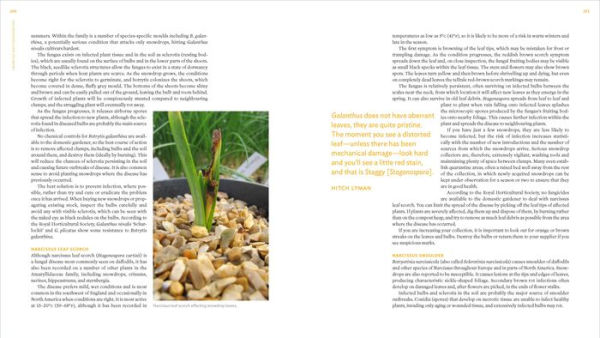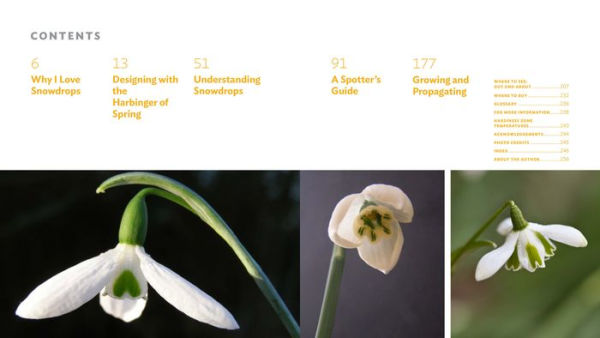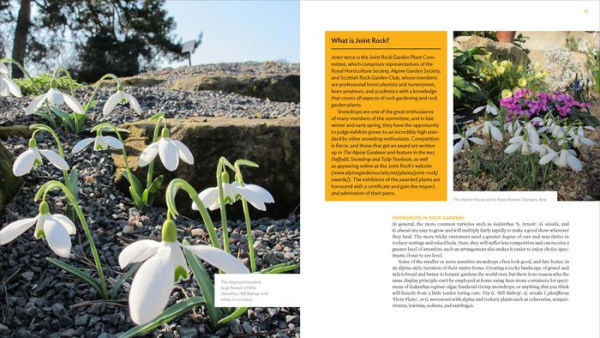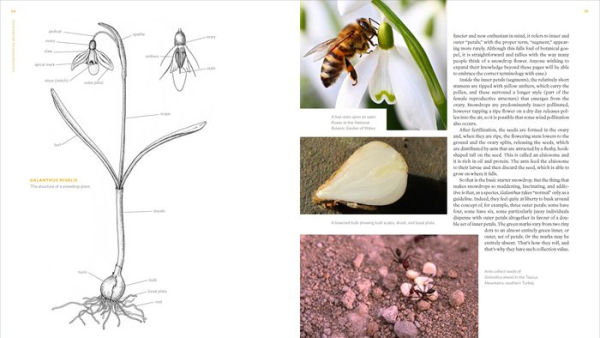Read an Excerpt
Introduction: Why I Love Snowdrops I have always had a soft spot for snowdrops. I spent much of my childhood in west Wales, where winters are unfailingly cold and damp, and by the beginning of the new year the landscape is a palette of soft taupe punctuated by flashes of defiant green from the moss and ivy and grey from lichen. The grass stems are bleached to fawn and bare hedgerows are rendered brown. In February, precious little is in flower, but each year, on Valentine’s Day, I would gather a little posy of snowdrops to give to my mother. It was a mystery to me why these ones, planted by my grandmother at the end of the garden, flowered before the massed snowdrops in the orchard, but there I knew they would always be, pearly heads pushing through the blanket of soggy grass—brave, sturdy, and reliable. Slipping into the chilly dawn in wellies and pyjamas in search of an innocent gift, I had no inkling of the passion that this little flower can inspire. But many years and many botanical love affairs later, I paid a February visit to Deborah Puxley, who owns Welford Park in Berkshire, an estate famous for its acres of snowdrops. I walked at sunrise in the quiet woods, empty but for a million snowdrops spreading out as far as the eye could see, and then drank coffee as visitors rolled in and Debby enthused about the festal open-day atmosphere. The following October I found myself interviewing esteemed botanist John Grimshaw, who was, at the time, “Mr Snowdrop” at Colesbourne Park, where some 250 cultivars are planted. He is a true snowdrop fanatic: even his teacups are decorated with named varieties. In the indoor gloom, he painted glorious, vivid pictures of creatures that I had yet to meet. He gave me a history lesson, debated conservation and botany with passion and intensity, and threw a little controversy into the mix for good measure. We then went outside to look at Galanthus reginae-olgae, which was just coming into flower, and which in autumn was so wrong. And so right. And so amazing. All at once. I was hooked. Visiting snowdrop gardens has recently become an essential part of the British calendar. Europe is not far behind and interest is building in North America, too. As the first high-impact flowers of spring, snowdrops have an enormous pull for a public eager for a spectacle and keen to get outdoors after the dark days of winter. By the end of January, in England, the general populace is suffering from cabin fever, and even those who are not serious gardeners can be found enjoying a rare day out. In their legions they throw off the shackles that the season imposes, admiring the flowers and enjoying tea and cake. Like the circus rolling into town for one night only, the mass appeal of snowdrops hangs, at least in part, on this ability to create an impressive and ephemeral impact. Alongside other garden favourites such as sweet peas and roses, snowdrops have an easy familiarity combined with an element of mystique. They appeal to everyone, regardless of situation, and in February gardens do a roaring trade. Snowdrops are hugely versatile plants. Just a few together are the most demure collection of flowers you could ever hope to meet; yet, given time, the vigorous varieties will spread and naturalize. They carpet woodland like the daisies that will later run riot across lawns and fields and the celandines that will turn rough grazing into a carpet of gold. But when spring does arrive, fickle gardeners find many other attractions to feast upon: fresher leaves and more brilliant flowers. In contrast to the perky daisies, snowdrops have no competition for the enjoyment of their charms. They may be small, but they arrive onto an empty, dark stage, lighting it up in the very depths of winter. And the hungry audience applauds. For me their appeal lies in their subtlety and diversity—together with the cosy familiarity of a plant that has always been there like part of the botanical furniture. And although dahlias, hostas, cacti, sweet peas, and fruit trees can all inspire devotion, there is no plant obsessive quite like a galanthophile. At open days, these folk can be found on their hands and knees searching for rarities. Nose to the ground, they peer under the skirts of the tiny flowers for unusual markings and variations in the shade of green, inspired by the fun of finding a new characteristic and the huge natural variety of the species. On the one hand, the simple flower is unmistakable: three outer petals and three inner ones at the top, strappy leaves at the bottom. On the other, both flowers and leaves can vary enormously in size and shape to be broad or narrow, big or small. The inner petal is usually stamped with a green inverted V, but some have two marks or none, and some are solidly green, and the colour can sneak onto the outer petals, too. Snowdrops show variations in poise, pose, and size—Galanthus nivalis f. pleniflorus ‘Blewbury Tart’ looks upward and the large flowers of G. ‘John Gray’ droop to the ground; G. ‘S. Arnott’ can be up to 30 cm (1 ft.) tall. Galanthus plicatus ‘Diggory’ is inflated like a balloon, and G. ‘Wasp’ has thin petals and insectoid striations. Fortunately, a lack of detailed knowledge is no barrier to enjoyment and, almost without exception, everyone likes snowdrops. They are just there, as they have always been; they require no specialist skills or equipment, and with gardens and shows to visit, their admirers do not even have to own any snowdrops themselves. As plants go, snowdrops are hugely accessible. They are also pleasantly easy-going. A few may be ill-tempered and difficult to grow, but most are satisfyingly vigorous, and the basic Galanthus nivalis—the snowdrop responsible for the great sheets of white in woodlands and orchards—is extraordinarily unfussy. In gardens, snowdrops will thrive in grass, under trees, and in borders. They do well under winter-flowering shrubs and alongside other early bulbs such as crocuses and irises. Sure, a spot of attention is appreciated—a bit of feeding here, a bit of division there—and they will perform better for it, but even in a regimen of neglect they will still gently spread, flowering reliably every year. As a collector’s item, snowdrops lend themselves to modern living. They don’t require any acreage, unlike cultivars of magnolias, apple trees, or even asters and their perennial ilk. Even a tiny garden can accommodate dozens of varieties, which get in an early display and then disappear accommodatingly underground as the show plays on through the seasons. I will hold up my hands, for I am not a fully fledged galanthophile and I remain in awe of those people who have “only” 250 varieties and describe themselves as interested amateurs. But plants never fail to set my world on fire, and in this book I hope to open the door on snowdrops to other plant lovers, whatever their level of interest. Galanthus is a fascinating genus, and although there are far too many cultivars out there to do them all justice, I have provided a flavour of their astonishing diversity, choosing varieties for their ease of cultivation and curiosity or the stories that whet the appetite. During my research, I have spoken to many experts, and I believe that true galanthophilia is about more than the plant; it is about the people, too—the old hands who take no nonsense and deal out advice and, occasionally, treasured specimens to those fortunate enough to meet them, and the charming, prickly, and besotted characters who have informed the history of the cultivated species and are spoken about with such fondness. In my joyous and occasionally abstract romp through snowdrop world, I rapidly discovered there is always another lead to pursue, always another rabbit hole to dive down, always another plant with an engaging backstory, and another expert to speak to. In snowdrops, as in life, the more one discovers, the more one realizes that there is much yet to learn. But there we have it. If snowdrops can be compared to chocolate (from the better class of chocolatier), my offering is a selection box to tempt, intrigue, and entice. It contains old favourites, hard centres, and nutty ones. Even those of us who profess a love of caramels might, on a bold day, be tempted to try the one with wasabi. At least for myself, I have opened a window on a few of the finer points of an already rather fine bulb. Every time I discovered something new and thought, Cool!, I wrote it down. If it gets the juices flowing with some dinner party–worthy facts and permits proficient botanical bluffing, then my work is done. Snowdrops are great: you can visit them, collect them, design with them, and enjoy them. I hope this book will help. It is for the avid and armchair gardener, for the potting shed and coffee table in equal measure. You can keep it in the glovebox of your car or read it in the bath. I have tried to convey the thrill that I feel when I fall in love with a plant, the exciting complexities of nomenclature and chemistry, the ethnobotany and social history, and the fantastic chaps who brought them home. This book is for anyone who, like me, can’t help but love a jolly good garden-worthy flower and will endlessly hunger for more.














